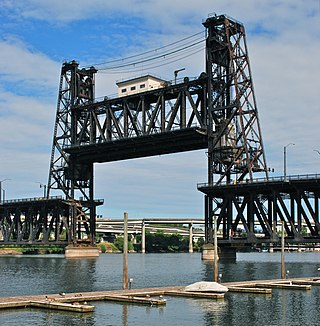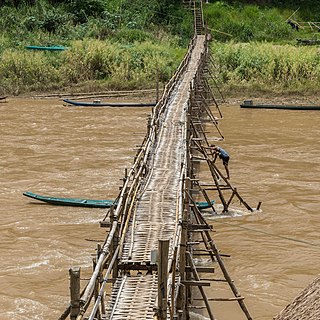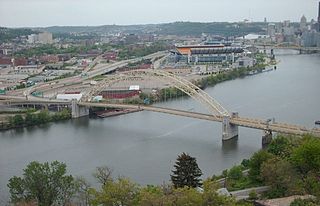
The Vlaardingse Vaart Bridge (also called The Twist) is a helical truss bridge for pedestrian and bicycle traffic over the Vlaardingervaart canal in Vlaardingen, Netherlands. [1] [2] [3]

The Vlaardingse Vaart Bridge (also called The Twist) is a helical truss bridge for pedestrian and bicycle traffic over the Vlaardingervaart canal in Vlaardingen, Netherlands. [1] [2] [3]
Vlaardingen is a city in the Netherlands in the western outskirts of Rotterdam, on the north bank of the Maas ( Meuse ), and the Vlaardingse Vaart Bridge is located in the outskirts of Vlaardingen. It links two Vlaardingen suburbs, Holy-Zuid on the east side of the bridge and Broekpolder on the west side. [1] The bridge has a span of 45 meters across the Vlaardingse Vaart, a canal that runs north from Vlaardingen to Schipluiden. [4]
The bridge's truss is made of 400 steel tubes, welded together and originally painted red; the color has since rapidly faded. [5] The truss's rectangular cross-section twists through a 90 degree angle along the span of the bridge, so that it is nearly horizontal at both ends of the bridge but diamond-shaped in the bridge's center. [2] [3] This design creates an illusion from some points of view that the bridge has collapsed, [1] but it also serves a functional purpose, damping vibrations from traffic on the bridge. [2]
The bridge was designed by Dutch firm West 8 beginning in 2005, with structural engineering consultation from another firm, ABT. It was prefabricated and then lifted into place in early 2009, and officially opened in April 2009. [2] [3] It was one of three finalists in the "best public space" category for the Dutch Design Awards in 2009. [6]

Vlaardingen is a city in South Holland in the Netherlands. It is located on the north bank of the Nieuwe Maas river at the confluence with the Oude Maas. The municipality administers an area of 26.69 km2 (10.31 sq mi), of which 23.57 km2 (9.10 sq mi) is land, with 73,924 residents in 2021.

The Steel Bridge is a through truss, double-deck vertical-lift bridge across the Willamette River in Portland, Oregon, United States, opened in 1912. Its lower deck carries railroad and bicycle/pedestrian traffic, while the upper deck carries road traffic, and light rail (MAX), making the bridge one of the most multimodal in the world. It is the only double-deck bridge with independent lifts in the world and the second oldest vertical-lift bridge in North America, after the nearby Hawthorne Bridge. The bridge links the Rose Quarter and Lloyd District in the east to Old Town Chinatown neighborhood in the west.

A bridge to nowhere is a bridge where one or both ends are broken, incomplete, or unconnected to any roads. If it is an overpass or an interchange, the term overpass to nowhere or interchange to nowhere may be used respectively.

The Sellwood Bridge is a deck arch bridge that spans the Willamette River in Portland, Oregon, in the United States. The current bridge opened in 2016 and replaced a 1925 span that had carried the same name. The original bridge was Portland's first fixed-span bridge and, being the only river crossing for miles in each direction, the busiest two-lane bridge in Oregon. The Sellwood Bridge links the Sellwood and Westmoreland neighborhoods of Portland on the east side with Oregon Route 43/Macadam Avenue on the west side. At its east end it leads to Tacoma Street. The bridge is owned and operated by Multnomah County. The original span of 1925 was a steel truss bridge, while its 2016 replacement is a deck-arch-type bridge.

A footbridge is a bridge designed solely for pedestrians. While the primary meaning for a bridge is a structure which links "two points at a height above the ground", a footbridge can also be a lower structure, such as a boardwalk, that enables pedestrians to cross wet, fragile, or marshy land. Bridges range from stepping stones–possibly the earliest man-made structure to "bridge" water–to elaborate steel structures. Another early bridge would have been simply a fallen tree. In some cases a footbridge can be both functional and artistic.

The Hercílio Luz Bridge, located in Florianópolis, the capital city of Santa Catarina State in southern Brazil, is the first bridge constructed to link the Island of Santa Catarina to the mainland.

The Burrard Street Bridge is a four-lane, Art Deco style, steel truss bridge constructed in 1930–1932 in Vancouver, British Columbia, Canada. The high, five part bridge on four piers spans False Creek, connecting downtown Vancouver with Kitsilano via connections to Burrard Street on both ends. It is one of three bridges crossing False Creek. The other two bridges are the Granville Bridge, three blocks or 0.5 km (0.31 mi) to the southeast, and the Cambie Street Bridge, about 11 blocks or 2 km (1.2 mi) to the east. In addition to the vehicle deck, the Burrard Bridge has 2.6 m wide sidewalks and a dedicated cycling lanes on both sides.

The Cambie Bridge is a six-lane, precast, box girder bridge spanning False Creek in Vancouver, British Columbia. The current bridge opened in 1985, but is the third bridge at the same location. Often referred to as the Cambie Street Bridge, it connects Cambie Street on the south shore of False Creek to both Nelson and Smithe Streets in the downtown peninsula. It is the easternmost of False Creek's fixed crossings; the Burrard and Granville bridges are a little more than a kilometre to the west, and the new Canada Line SkyTrain tunnel is built just west of the Cambie Bridge.

The Big Four Bridge is a six-span former railroad truss bridge that crosses the Ohio River, connecting Louisville, Kentucky, and Jeffersonville, Indiana. It was completed in 1895, updated in 1929, taken out of rail service in 1968, and converted to bicycle and pedestrian use in 2014. The largest single span is 547 feet (167 m), with the entire bridge spanning 2,525 feet (770 m). It took its name from the defunct Cleveland, Cincinnati, Chicago and St. Louis Railway, which was nicknamed the "Big Four Railroad".

The West End Bridge is a steel tied-arch bridge over the Ohio River in Pittsburgh, Pennsylvania, approximately 1 mile (1.6 km) below the confluence of the Allegheny and Monongahela Rivers. It connects the West End to the Chateau neighborhood on the North Side of Pittsburgh.

Blackfriars Bridge in London, Ontario, Canada is a wrought iron bowstring arch through truss bridge, crossing the North Thames River. The bridge was constructed in 1875 and carries single-lane vehicles, bicycles and pedestrians from Blackfriars Street to Ridout Street North.

The Intercity Viaduct is an automobile and pedestrian crossing of the Kansas River in the United States. Designed by Waddell and Hedrick, this four lane, two level deck truss bridge opened to the public on January 29, 1907. It rises above the West Bottoms, and several sets of railroad tracks. It was the first roadway bridge to connect Kansas City, Missouri, with Kansas City, Kansas, non-stop all the way across. It is about 1.5 miles (2.4 km) long and carries eastbound traffic for Interstate 70 (I-70)/U.S. Route 24 (US 24)/US 40/US 169, while its sister bridge, the Lewis and Clark Viaduct, built in 1962, carries westbound traffic.

Shaw Bridge, also known as Double-Span Whipple Bowstring Truss Bridge, is a historic bridge in Claverack, New York, United States. It carried Van Wyck Lane over Claverack Creek, but is now closed to all traffic, even pedestrians. It is "a structure of outstanding importance to the history of American engineering and transportation technology." Specifically designed by John D. Hutchinson, the bridge employs the basic design of Squire Whipple. It is the only extant "double" Whipple bowstring truss bridge in the U.S., having two identical spans placed in series over a common pier.

West 8 is an urban planning and landscape architecture firm founded by Adriaan Geuze and Paul van Beek in Rotterdam, Netherlands in 1987. It is known for its contemporary designs and innovative solutions to urban planning problems using lighting, metal structures, and color. Van Beek is no longer part of the firm.

The Don Burnett Bicycle-Pedestrian Bridge, renamed from Mary Avenue Bridge on July 19, 2011, is a cable-stayed bridge over Interstate 280 (California), spanning Cupertino, California and Sunnyvale, California, used for bicycle and pedestrian traffic. It is the only cable-stayed pedestrian bridge over a highway in California. At night the bridge is lit up and can be seen by those driving on Interstate 280. The project was awarded a Helen Putnam Award of Excellence. It also won the California Transportation Foundation's Pedestrian/Bicycle Project of the Year.

The Healdsburg Memorial Bridge is a steel truss bridge across the Russian River in Healdsburg, California, listed in the National Register of Historic Places. It can be seen from nearby U.S. Route 101 and is "Healdsburg's abiding structural symbol".

The Nescio Bridge is a cycle and footbridge in the Netherlands. This curved, steel suspension bridge, located in Amsterdam, is the country's first suspension bridge that carries only a cycle track and footway, and at almost 800 metres length it is also one of the country's longest cycle and footbridges. Additionally, it is the longest single cable suspension bridge in the Netherlands.

The James D. Pfluger Pedestrian and Bicycle Bridge is a shared use bridge for pedestrians and cyclists spanning Lady Bird Lake in downtown Austin, Texas. Opened in 2001, the bridge connects the north and south sides of the Ann and Roy Butler Hike-and-Bike Trail and features an unusual "double curve" design. The bridge runs parallel to the Lamar Boulevard Bridge, which carries road traffic across the lake roughly 200 feet (61 m) to the west.

The Vlaardingervaart or Vlaardingse Vaart is a canal in the municipality of Midden-Delfland in the Dutch province of South Holland, between the Gaag in Schipluiden and Vlaardingen, where through the Oude Haven the water is connected to the Nieuwe Maas.

The Entrepotdok, formerly Nieuwe Rapenburgergracht, is a canal in Amsterdam, and a street and row of former warehouses with the same name along the northeast side of the canal. They were constructed between 1708 and 1829, used for storage, squatted in the 1990s and are now converted into apartments. Entrepotdok is the largest inhabited warehouse complex in Amsterdam. The canal runs between the Kadijksplein and Sarphatistraat, and is parallel to Hoogte Kadijk, Laagte Kadijk, Plantage Doklaan and Natura Artis Magistra zoo.